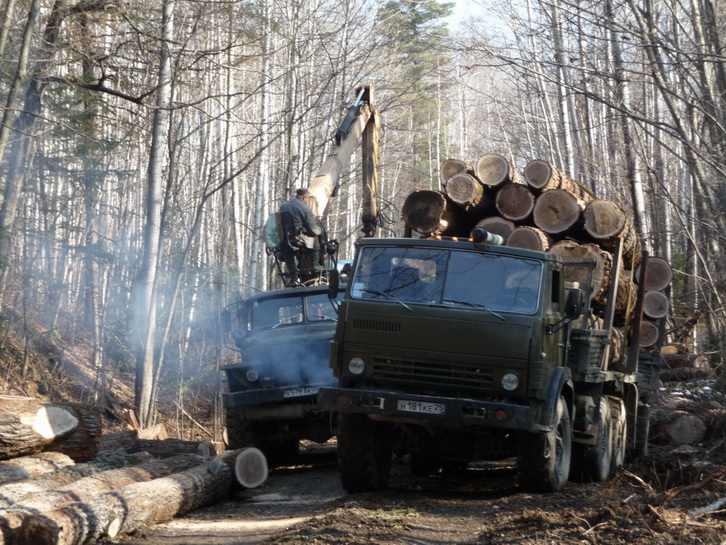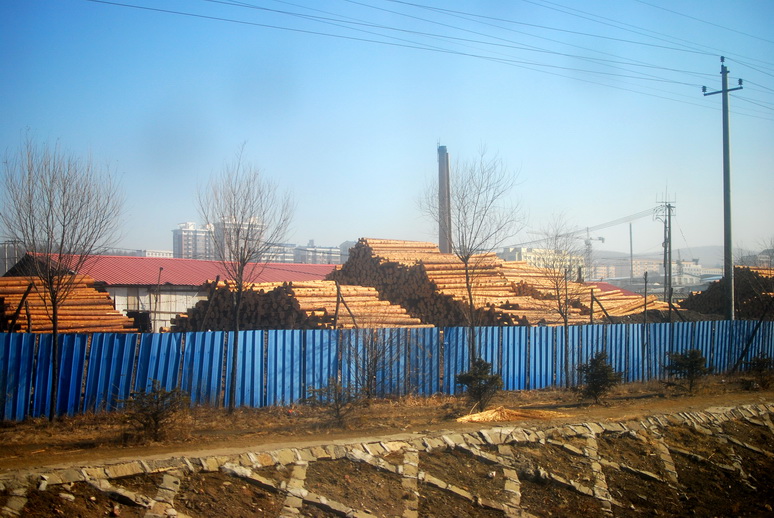With Chinese demand for hardwood rising, large swathes of forests are being illegally logged. Corruption and fear are hampering a crackdown.
VLADIVOSTOK—THE vast forests of Russia’s Far East are being plundered. Prompted by rising Chinese demand for timber and enabled by a culture of official corruption and fear, environmentalists say a Russian forest mafia is stripping the region of rare and valuable hardwoods, a trade that threatens the world’s last remaining populations of Siberian tigers.
In China, timber is processed into finished consumer products such as veneers, picture frames and wooden toilet seats, many of which end up on shelves in the West, the endpoint of a pernicious and largely unacknowledged global market chain. Despite statements of concern from the Russian authorities, the logging industry is ‘now beyond federal control, and overrun by criminal gangs’, according to Dark Forest, a recent TV exposé of the official corruption at the heart of the trade.
Most illicit timber originates in the conifer-broadleaved forests of the Sikhote-Alin Mountain Range, which extends northward from Russia’s Primorksy region for more than a thousand kilometres. In a 2007 report, the Washington-based Environmental Investigation Agency described the region as containing ‘one of the most diverse assemblages of plant and animal species in temperate forests anywhere on the planet’.

Illegal timber is transported from the Tayozhniy Wildlife Refuge, Far East Russia, in 2010. (Michael Stuewe/WWF).
Known to environmentalists as the Ussuri taiga, the area is home to an unusual profusion of hardwood species, including varieties of ash, maple, elm and oak. It also supports the last remaining populations of Siberian tiger, the largest of the world’s big cats, whose wild population now numbers in the hundreds. Denis Smirnov, the head of the forestry program at the World Wildlife Fund’s Amur branch office, says that by destroying the food sources of tiger prey, illegal logging could endanger the existence of the Siberian tiger in the wild. ‘There’s a direct link between the damage caused by illegal logging and the state of the tiger population,’ says Smirnov, a St. Petersburg native who has been working in the Far East for the past nine years.
Around 60,900 cubic metres of hardwoods are illegally exported from Far East Russia each year, according to lowball official figures, but the WWF puts the annual total at ‘at least 1 million’, a figure calculated by comparing the permitted amount of export logging with estimates of the actual exports. ‘It’s incomparable, the detected and the actual,’ Smirnov says. ‘According to our evaluation, the percentage of the share of illegal wood in this hardwood flow is up to 75 percent.’
Rogue timber operators gained a foothold following the fall of the Soviet Union, when many of the region’s logging towns were hit by unemployment after the collapse of state support for the industry. Many jobless former loggers have since turned to illegal small-scale timber harvesting as a way of making ends meet. ‘Providing their services to the “Forest Mafia” is often their only source of income,’ states a recently leaked diplomatic cable from the US Consulate in Vladivostok, dated January 2009. ‘Established companies are often finding it more profitable to use the services of these out-of-work villagers cutting down trees in unauthorised areas than to use legal, established channels.’ Demand was also spurred by the opening of the Chinese border in the mid-1990s and the imposition of Chinese logging bans in response to flooding in Northeast China in 1997.
The main Chinese transit point for Russian timber is Suifenhe, a sprawling border city of concrete apartment blocks and onion-domed shopping malls, the latter an architectural nod to the city’s origin as an outpost of Tsarist Russia and a muted sales pitch, perhaps, to the busloads of Russians who cross the border each day to buy up cheap Chinese clothing and electronics. Crossing into China from the Russian border, signs of the timber trade are readily apparent: on its approach, the railway snakes its way through a seemingly endless series of timber yards, piled high with uncut logs and milled timber planks. At the highway border crossing, too, trucks rumble past, laden with milled planks.
Anatoly Lebedev, a Vladivostok-based ecologist who has been campaigning against illegal logging since the early 1990s, says as many as ten trains arrive in Suifenhe from Russia each day, each bearing 60 loaded cars holding around 60 cubic metres of timber – much of it illegal.
According to the WWF, an estimated 30 percent of illegal timber originates from legitimate concession holders, who underestimate the amount of timber stock in their concession areas and then covertly export the remainder. A larger concern, however, are the small- and medium-scale operators who work beneath the official radar in protected areas. A widely-abused loophole is to apply for a license to conduct ‘sanitary’ logging – the removal, for maintenance purposes, of dead or dying trees – which is then used as legal cover for the clear-felling of valuable hardwood. Rigorous customs inspections can easily be sidestepped through the use of forged legal documents or fraudulent declarations.
Russian officials have repeatedly voiced concerns about the forestry situation. In 2008,Valery Roshchupkin, head of the Russian Ministry of Natural Resource’s Federal Agency for Forestry, issued a report claiming that the country was putting in place a new national forest policy, including ‘a tough customs policy’, to staunch the flow of illegal timber. Since Dark Forest aired on Russian TV in May 2010, however, the federal government has also faced a considerable public backlash. In response to the film, which caught Primorsky region forestry chief Pyotr Diyuk on camera admitting complicity in the illegal timber trade, Moscow again promised investigations.

Russian logs are piled high in a timber yard along a railway close to the Russian border in Suifenhe, China. (Sebastian Strangio)
But due to the region’s endemic levels of corruption (another post-Soviet legacy) the disincentives remain overwhelmingly weak: the cost of operating ‘legally’ in Russia, with its heavy burden of taxes and unofficial ‘fees’, makes on the books forestry largely unprofitable. Lebedev alleges that officials at all levels are on the take.
‘This system is very specifically created by government officials – local, regional and national – and they get a good profit from this activity, and that’s why they always defend this illegal business,’ he says. ‘This is the essence of Russian corruption.’
Battling such entrenched interests can also be risky. During the 2008-09 winter, the summer house of Yuriy Bersenev, one of Smirnov’s WWF colleagues, was burnt to the ground by unknown perpetrators. A day before the fire, which followed a Russian TV story about the organisation’s work, Smirnov said he was also the indirect victim of a ‘traffic accident’ in the countryside. ‘The son of one of our colleagues died in quite a strange traffic accident, and it has still not been investigated,’ Smirnov says.
In particular danger of retribution are the local informants that apprise activists of the situation on the ground. Smirnov says residents in one Primorsky settlement who sent a series of letters to the region’s governor requesting action against illegal logging had the windows of their cars and houses shot out. Local police, he said, then ‘discouraged’ the residents from lodging any further complaints.
In spite of the obstacles, activists say some progress is being made. In 2007, WWF succeeded in getting two forest management officials fired and arrested for their complicity in helping loggers to operate in the Tayozhniy wildlife refuge, a key tiger breeding ground in the Khabarovsk region.
The following year, the US Congress passed an amendment to the Lacey Act, an existing anti-wildlife trafficking law, extending its prohibitions to the import of illegally-sourced wood and wood products. Given the amount of the timber that ends up in US markets – the US diplomatic cable cites estimates that up to 90 percent of hardwoods from the Russian Far East reach the United States – campaigners say large-scale retailers such as Walmart could deal a blow to the timber trade by dumping rogue Chinese suppliers. At the time of its passage, Alexander von Bismarck, the executive director of the EIA, which spearheaded the coalition supporting the ban, said the amendment marked ‘a new phase in the global effort to improve forest governance’.
Whether the US legislation will make any difference remains an open question – due to the lack of monitoring capacity in China, some are sceptical – but the Siberian tiger also has a powerful friend in Russia’s prime minister (and avid outdoorsman) Vladimir Putin. After the international Tiger Summit in St. Petersburg in November, Putin signed into law a ban on the logging of Korean pine, a nut-bearing species vital to the tiger’s survival.
Next year’s APEC Summit, when the world’s eyes will be on the host city Vladivostok, could also provide a spur for the government to investigate forestry crimes, with Moscow keen to transform the image of the Far East as a ‘wild east’ plagued by corruption and neglect. For environmentalists, however, promises of ‘comprehensive’ investigations have a familiar hollow ring.
‘The question is’, says Smirnov, ‘will it be photo campaign, or will it make real changes to the structure?’
[Published in the The Diplomat, April 21, 2011]



